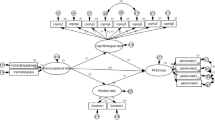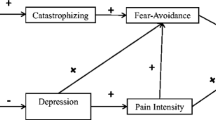Abstract
This study evaluated the relation of particular aspects of pain-related anxiety to characteristics of chronic pain distress in a sample of 76 individuals with low-back pain. Consistent with contemporary cognitive–behavioral models of chronic pain, the cognitive dimension of the Pain Anxiety Symptoms Scale (PASS; McCracken, Zayfert, and Gross, 1992, Pain 50: 67–73) was uniquely predictive of cognitive-affective aspects of chronic pain, including affective distress, perceived lack of control, and pain severity. In contrast, the escape and avoidance dimension of the PASS was more predictive of behavioral interference in life activities. Overall, the findings are discussed within the context of identifying particular pain-related anxiety mechanisms contributing to differential aspects of pain-related distress and clinical impairment.
Similar content being viewed by others
References
Arntz, A., and Peters, M. (1995). Chronic low back pain and inaccurate predictions of pain: Is being too tough a risk factor for the development and maintenance of chronic pain? Behav. Res. Ther. 33: 49-53.
Asmundson, G. J. G. (1999). Anxiety sensitivity and chronic pain: Empirical findings, clinical implications, and future directions. In Taylor, S. (Ed.), Anxiety Sensitivity: Theory, Research, and Treatment of the Fear of Anxiety, Erlbaum, Mahwah, NJ, pp. 269-285.
Asmundson, G. J. G., Kuperos, J. L., and Norton, G. R. (1997). Do patients with chronic pain selectively attend to pain-related information? Preliminary evidence for the mediating role of fear. Pain 72: 27-32.
Asmundson, G. J. G., Norton, P. J., and Norton, G. R. (1999). Beyond pain: The role of fear and avoidance in chronicity. Clin. Psychol. Rev. 19: 97-119.
Asmundson, G. J. G., and Taylor, S. (1996). Role of anxiety sensitivity in pain-related fear and avoidance. J. Behav. Med. 19: 573-582.
Barlow, D. H. (1991). Disorders of emotion. Psychol. Inq. 2: 58-71.
Burckhardt, C. S., and Bjelle, A. (1994). A Swedish version of the Short Form McGill Pain Questionnaire. Scand. J. Rheumatol. 23: 77-81.
Burns, J. W., Mullen, J. T., Higdon, L. J., Wei, J. M., and Lansky, D. (2000). Validity of the Pain Anxiety Symptoms Scale (PASS): Prediction of physical capacity variables. Pain 84: 247-252.
Carter, L. E., McNeil, D. W., Vowles, K. E., Sorrell, J. T., Turk, C., Ries, B., and Hopko, D. R. (2002). Effects of emotion on pain reports, tolerance and physiology. Pain Res. Manage. 7: 21-30.
Clark, D. A., Beck, A. T., and Brown, G. (1989). Cognitive mediation in general psychiatric outpatients: A test of the content-specificity hypothesis. J. Pers. Soc. Psychol. 56: 958-964.
Coft, P. R., Papageorgio, A. C., Thomas, E., Jayson, M. I., and Silman, A. J. (1995). Psychologic distress and low back pain. Evidence from a prospective study in the general population. Spine 15: 2731-2737.
Cox, B. J. (1996). The nature and assessment of catastrophic thoughts in panic disorder. Behav. Res. Ther. 34: 363-374.
Craig, K. D. (1994). Emotional aspects of pain. In Wall, P. D. and Melzack, R. (Eds.), The Textbook of Pain, Churchill Livingstone, Edinburgh, pp. 261-274.
Crombez, G., Vlaeyen, J. W. S., Heuts, P. H. T. G., and Lysens, R. (1999). Pain-related fear is more disabling than pain itself: Evidence on the role of pain-related fear in chronic back pain disability. Pain 80: 329-339.
Eifert, G. H., Zvolensky, M. J., Sorrell, J. T., Hopko, D. R., and Lejuez, C. W. (1999). Predictors of self-reported anxiety and panic symptoms: An evaluation of anxiety sensitivity, suffocation fear, heart-focused anxiety, and breath-holding duration. J. Psychopathol. Behav. Assess. 21: 293-305.
Ferrari, R., Novara, C., Sanavio, E., and Zerbini, F. (2000). Internal structure and validity of the Multidimensional Pain Inventory, Italian language version. Pain Med. 1: 123-130.
Frymoyer, J. W. (1993). Quality: An international challenge to the diagnosis and treatment of the disorders of the lumbar spine. Spine 18: 2147-2152.
Georgoudis, G., Oldham, J. A., and Watson, P. J. (2001). Reliability and sensitivity measures of the Greek version of the short form of the McGill Pain Questionnaire. Eur. J. Pain 5: 109-118.
Georgoudis, G., Watson, P. J., and Oldham, J. A. (2000). The development and validation of a Greek version of the short-form McGill Pain Questionnaire. Eur. J. Pain 4: 275-281.
Hadjistavropoulos, H. D., and LaChapelle, D. L. (2000). Extent and nature of anxiety experienced during physical examination of chronic low back pain. Behav. Res. Ther. 38: 13-29.
Hoffman, R. M., Wheeler, K. J., and Deyo, R. A. (1993). Surgery for herniated discs: A literature synthesis. J. Gen. Intern. Med. 8: 487-496.
Jensen, M. P., Turner, J. A., and Romano, J. M. (1994). Correlates of improvement in multidisciplinary treatment for chronic pain. J. Consult. Clin. Psychol. 62: 172-179.
Kerns, R. D., Turk, D. C., and Rudy, T. E. (1985). The West Haven–Yale Multidimensional Pain Inventory. Pain 23: 345-356.
Kori, S. H., Miller, R. P., and Todd, D. D. (1990). Kinesiophobia: A new view of chronic pain behavior. Pain Manage. 3: 35-64.
Lethem, J., Slade, P. D., Troup, J. D. G., and Bentley, G. (1983). Outline of a fear-avoidance model of exaggerated pain perception–I. Behav. Res. Ther. 21: 401-408.
McCracken, L. M. (1997). “Attention” to pain in persons with chronic pain: A behavioral approach. Behav. Ther. 28: 271-284.
McCracken, L. M., Faber, S. D., and Janeck, A. S. (1998). Pain-related anxiety predicts nonspecific physical complaints in persons with chronic pain. Behav. Res. Ther. 36: 621-630.
McCracken, L. M., and Gross, R. T. (1998). The role of pain-related anxiety reduction in the outcome of multidisciplinary treatment for chronic low back pain: Preliminary results. J. Occup. Rehabil. 8: 179-189.
McCracken, L. M., Gross, R. T. and Eccleston, C. (2002). Multimethod assessment of treatment process in chronic low back pain: Comparison of reported pain-related anxiety with directly measured physical capacity. Behav. Res. Ther. 40: 585-594.
McCracken, L. M., Gross, R. T., Sorg, P. J., and Edmunds, T. A. (1993a). Prediction of pain in patients with chronic low back pain: Effects of inaccurate prediction and pain-related anxiety. Behav. Res. Ther. 31: 647-652.
McCracken, L. M., Zayfert, C., and Gross, R. T. (1992). The Pain Anxiety Symptoms Scale: Development and validation of a scale to measure fear of pain. Pain 50: 67-73.
McCracken, L. M., Zayfert, C., and Gross, R. T. (1993b). The Pain Anxiety Symptoms Scale: A multimodal measure of pain specific anxiety symptoms. Behav. Therap. 16: 183-184.
McNally, R. J., and Eke, M. (1996). Anxiety sensitivity, suffocation fear, and breath-holding duration as predictors of response to carbon dioxide challenge. J. Abnorm. Psychol. 105: 146-149.
McNeil, D. W., and Rainwater, A. J. (1998). Development of the Fear of Pain Questionnaire–III. J. Behav. Med. 21: 389-410.
Melzack, R. (1987). The short-form McGill Pain Questionnaire. Pain 30: 191-197.
Melzack, R., and Katz, J. (2001). The McGill Pain Questionnaire: Appraisal and current status. In Turk, D. C., and Melzack, R. (Eds.), Handbook of Pain Assessment, 2nd ed., Guilford, New York, pp. 35–52.
Miaskowski, C. (1999). The role of sex and gender in pain perception and responses to treatment. In Gatchel, R. J., and Turk, D. C. (Eds.), Psychosocial Factors in Pain: Critical Perspectives, Guilford, New York, pp. 401-411.
Mogg, K., and Bradley, B. P. (1998). A cognitive-motivational analysis of anxiety. Behav. Res. Ther. 36: 809-848.
Nachemson, A. L. (1992). Newest knowledge of low back pain. Clin. Orthop. 279: 8-20.
Rachman, S. J. (1991). Disorders of emotion: Causes and consequences. Psychol. Inq. 2: 86-87.
Schmidt, N. B. (1999). Examination of differential anxiety sensitivities in panic disorder: A test of anxiety sensitivity subdomains in predicting fearful responding to a 35% CO2 challenge. Cogn. Ther. Res. 23: 3-19.
Tollison, C. D., Kriegel, M. L., and Downie, G. R. (1985). Chronic low back pain: Results of treatment at the pain therapy center. South. Med. J. 78: 1291-1300.
Turk, D. C. (1990). Customizing treatment for chronic pain patients: Who, what, and why? Clin. J. Pain 6: 255-270.
Turk, D. C., and Okifuji, A. (2002). Psychological factors in chronic pain: Evolution and revolution. J. Consult. Clin. Psychol. 70: 678-690.
Vlaeyen, J. W. S., and Linton, S. J. (2000). Fear-avoidance and its consequences in chronic musculoskeletal pain: A state of the art. Pain 85: 317-332.
Vlaeyen, J. W. S., Seelen, H. A. M., Peters, M., de Jong, P., Aretz, E., Beisiegel, E., and Weber, W. E. J. (1999). Fear of movement/(re)injury and muscular reactivity in chronic low back pain patients: An experimental investigation. Pain 82: 297-304.
Vowles, K. E., and Gross, R. T. (2003). Work-related beliefs about injury and physical capability for work in individuals with chronic pain. Pain 101: 291-298.
Waddell, G. (1987). A new clinical model for the treatment of low back pain. Spine 12: 632-644.
Waddell, G., and Main, C. J. (1984). Assessment of severity in low back pain disorders. Spine 9: 204-208.
Waddell, G., Somerville, D., Henderson, I., and Newton, M. (1992). Objective clinical evaluation of physical impairment in chronic low back pain. Spine 17: 617-628.
Zinbarg, R. E. (1998). Concordance and synchrony in measures of anxiety and panic reconsidered: A hierarchical model of anxiety and panic. Behav. Ther. 29: 301-323.
Zvolensky, M. J., Goodie, J. L., McNeil, D. W., Sperry, J. A., and Sorrell, J. T. (2001). Anxiety sensitivity in the prediction of pain-related fear and anxiety in a heterogeneous chronic pain population. Behav. Res. Ther. 39: 683-696.
Author information
Authors and Affiliations
Corresponding author
Rights and permissions
About this article
Cite this article
Vowles, K.E., Zvolensky, M.J., Gross, R.T. et al. Pain-Related Anxiety in the Prediction of Chronic Low-Back Pain Distress. J Behav Med 27, 77–89 (2004). https://doi.org/10.1023/B:JOBM.0000013645.40613.42
Issue Date:
DOI: https://doi.org/10.1023/B:JOBM.0000013645.40613.42




